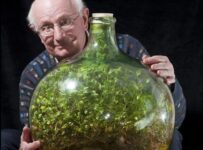
Latimer’s Bottle Garden Grows Without Water for More Than 50 Years: How Does It Survive?
Can a plant survive if it has not been watered for more than 50 years? Evidently yes, as evidenced by the garden in a bottle made in 1960 by the 80-year-old British David Latimerthat the last time the US president saw the watering can was Richard Nixon, way back in 1972. This garden in a bottle – which is an ecosystem in self-sustaining regime for decades – is closed by a plastic cork, but it is not immune to the outside. In fact, it absorbs sunlight, and it is thanks to this that it can carry out photosynthesis, a process by which sunlight is converted into the energy needed to grow.
Photosynthesis is also enabled by the fact that when parts of the plant die, the bacteria in the compost at the bottom of the bottle use oxygen to break down the dead parts, releasing carbon dioxide, allowing this process to continue. Furthermore, it is true that it is not watered, but the water inside it is enough to keep it going: from the roots it passes to the leaves, condenses, falls onto the compost and returns to the roots, thus making the water continuously available.
When Latimer’s Bottle Garden Was Born and How He Made It
On Easter Sunday twelve years ago, in 1960Latimer carefully composed this little bottled garden, first putting some compost on the bottom into which he then inserted some seeds of Tradescantiathen watered the whole thing with about half a liter of water and closed the bottle with a plastic cork. He didn’t open it again for twelve years, and the plant grew in a corner of the house under direct sunlight. In 1972 Latimer thought that the plant might be a bit dryand so he took the cork out and gave her water (just a quarter of a pint), but then decided he would never take the cork out again until it was necessary. That time, however, has not yet come.

Latimer, who moreover he never pruned the planthas kept it in the basement of his home in Cranleigh for more than thirty years, at a temperature of around 13 degrees centigradeperfect for reducing her need for care and therefore making her live as long as possible.
How does the bottle garden survive?

Let’s start by saying that the plant undergoes the influence of external sunlight (which, as we mentioned at the beginning, allows photosynthesis) and a modest air exchange through the cork (the plastic cover that acts as a cap to the bottle). In this way the temperature of the internal ecosystem is in balance.
If after all these years the plant is still alive, however, it is not only for these two reasons, but also because recycles its resources.
Photosynthesis transforms carbon dioxide into oxygen, which allows the plant to grow. When some of its parts rot, there is a recycling of carbon and humidity, which returns to the environment, and it is thanks to these factors that the plant has enough energy to grow. In particular, the humidity accumulated in the bottle represents a source of water that cyclically returns to the roots: the condensation in the upper area, in fact, periodically falls on the other areas of the plant that are below, reaching the compost and the roots, where it is absorbed, sent to the leaves and then returns again in the form of condensation.
There is also another detail that should not be overlooked. Tradescantia or grass miserya type of plant that has small, unremarkable flowers, bends (somewhat sadly) over itself and does not require much resources to grow (which is why it is a very difficult weed to eradicate in nature). Despite requiring very little care, from the latest photos available it is clear that the Latimer plant It hasn’t had any flowers for many yearsso it’s certainly not in as great shape as it was a while back.
Will the jar ever be opened?
Opening the pot could mean the death of the plant, and for this very reason for now the option was discarded. When and if the plant begins to show signs of serious failure, this path can be considered again.
It is certain that Mr. Latimer is already of a certain age, and that he has stated that if his children do not want the plant, upon his death it will be donated to the Royal Horticultural Society.



